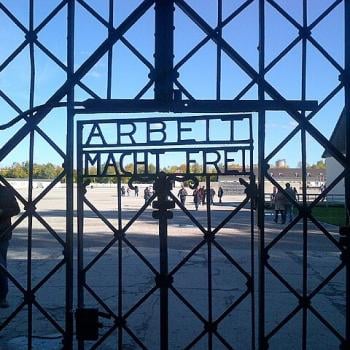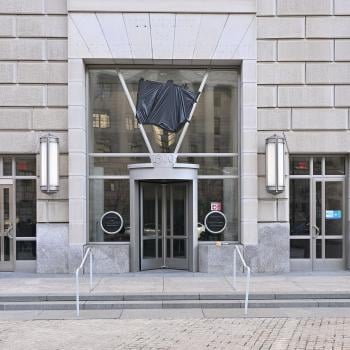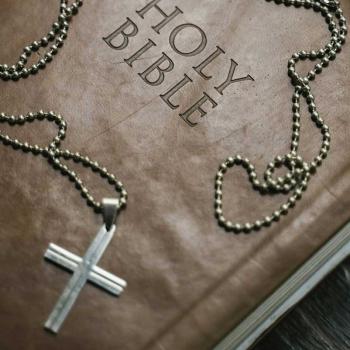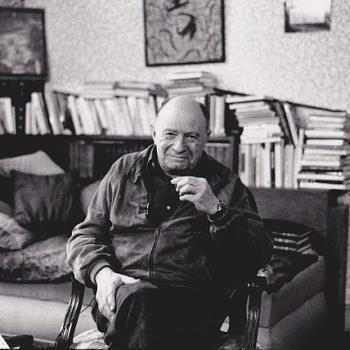Growing Up “Evangelical” in the 1950s/1960s: “Look What They’ve Done to My Religion”
To me the classic version of the old song “Look What They’ve Done to My Song (Ma)” will always be Ray Charles’s (no offense to Miley Cyrus). When I think about contemporary American evangelical Christianity compared with the 1950s/1960s version I grew up in, somehow that song comes to mind. What have they done to my religion?
Oh, I know all the routine responses to such nostalgic questions: “There never was a ‘golden age’ so get over it;” “Nostalgia corrupts vitality in religion;” “The good old days—weren’t they just awful?” And, of course, memory is never as reliable as we like to think.
Still, I have trouble finding any Christian form of life comparable with what we called “evangelical Christianity” in the 1950s and 1960s (although I suspect it began to die in the later 1960s). I wonder if we’ve lost something precious and valuable? Have we thrown the babies out with the bathwater—as we have evolved as a religious form of life?
Sure, that late, great evangelical movement was never as great as some of us would like to think and it’s not entirely “late” (as in dead). There are remnants around. But I have no doubt something drastic happened to change it such that I barely recognize anything called “evangelical” as continuous with what I knew of that spiritual form of life as a child and youth.
Why bemoan the demise of a movement? They all come and go; none is God’s kingdom itself. So true. And yet there are still people who talk about “evangelical Christianity” as if there was some continuity over the decades of my life. I have trouble finding that continuity.
Know that I am not really talking here about any organization; there never was an evangelical headquarters or anything like it (although some people liked to joke that Wheaton, Illinois was about as close as one could come to that). No, I’m talking about a very wide spread and powerful Christian form of life—a spirituality with a theology or a theology with a spirituality. We (my family and I, my church and I) knew who our “fellow evangelicals” were. There was no litmus test or card-carrying membership; it was a matter of discernment.
When I was in public school as an evangelical pastor’s kid, I knew which of my fellow students were evangelical and which were not. Evangelicals at least occasionally read their Bibles during “study hall” and at least occasionally “witnessed” to fellow students. Evangelicals didn’t curse, didn’t smoke, didn’t drink alcohol, didn’t dance, didn’t go to movies. We were “separated” from “worldliness.” Of course there were kids who did all those things and came from evangelical families, but they were considered “backslidden” by the rest of us.
How did we know each other and make such judgments? Well, in primary school we had “Back Yard Clubs.” Kids who attended them (or something like them) were evangelicals; kids who shunned them (or anything like them) weren’t. In junior high school (middle school) we had Campus Life groups—often with a teacher as our sponsor. In high school we had Youth for Christ events. And, of course, there were the churches. If a kid attended a Baptist church you could be pretty sure he was supposed to be evangelical; if he attended a Lutheran church he had to prove himself if he claimed to be Christian at all! (Catholics had no chance of being considered Christian by evangelicals then.)
Evangelicals went to churches whose pastors belonged to the “Evangelical Ministers Alliance” instead of the “Citywide Ministerial Alliance.” Evangelical high school graduates-to-be attended a baccalaureate sponsored by the Evangelical Ministerial Alliance whereas non-evangelicals attended the one sponsored by the city’s “mainline” ministerial alliance. (The one sponsored by the so-called “mainline” ministerial alliance at the time of my high school graduation was an anti-Vietnam War rally.)
To be sure there was some cross over between the evangelical and the “mainline” communities. A few Baptists, for example, attended both meetings. But we “solid evangelicals” were a little suspicious of that—until the 1970s anyway. Fundamentalist Baptists and Bible churches generally didn’t affiliate with either of the two community ministers’ groups. Nor did the Churches of Christ.
To us 1950s/1960s evangelicals there were really only four kinds of churches (with “church” being used only formally in this context): Catholic (not Christian at all), “mainline,” “ecumenical” Protestant (mostly not Christian but with a few scattered Christians who had not yet “come out from among them”), evangelical (us, the true Christians but of many different denominations), and “cults” (Mormons, Jehovah’s Witnesses, Churches of Christ, etc.). We thought the separatist fundamentalists and the African-American churches belonged to us but just didn’t know it yet.
In most American cities the “evangelical” churches were those that 1) enthusiastically supported and cooperated with Billy Graham crusades, 2) believed a person must be “born again” to be saved, 3) preached from the Bible only and encouraged Bible reading and study by every member, 4) talked about Jesus a lot—as the only Savior and personal friend (“personal relationship with Jesus Christ”), 5) avoided “worldly entertainments” and use of harmful substances (alcohol and tobacco), 6) discouraged dancing and attending “Hollywood films” in movie theaters, 7) cooperated with Youth for Christ events, 8) used evangelical Sunday School curricula and hung around the evangelical “Book and Bible store” (not the Catholic “religious goods” store or the “mainline” Protestant “Christian bookstore”), 9) showed Christian films in church (most produced by Billy Graham-affiliated film companies), and 10) believed in basic, orthodox Christian doctrines such as the Trinity.
Now, a lot of that was “evangelical subculture” stuff and I don’t yearn for all of it to return. However, what is missing today, among those churches and Christians who call themselves “evangelical,” is the 1950s/1960s evangelical sense of being different, of not being “conformed to this world,” of resisting accommodation to secularism and popular culture. At least we talked that way even if we (many of us) did accommodate to secularism and popular culture in our own ways. (In the church of my childhood we thought Hank Williams and Dwight Eisenhower were evangelical Christians.)
Back then American evangelicals by-and-large eschewed political activism. That was “worldly stuff” and a waste of time and energy. Our focus was on missions and evangelism. We always had a “missionary barrel” (or two or three) sitting in the church foyer and you couldn’t go a month or two without having a “missionary Sunday” with a visiting missionary showing his (or in our denomination her ) slides that always ended with a sun setting over a tropical rainforest (or something like that). We talked much about heaven and tended to care little about this world except to stay away from its “allurements”—wealth, sex (other than within marriage for reproduction), drugs of all kinds (including alcohol and tobacco), secular music (other than Hank Williams and maybe the Ray Conniff Singers), etc. When was the last time most evangelical churches had “missionary Sunday” with a visiting missionary preaching and “calling out the call” for the church’s youth to become missionaries?
I could go on and on talking about the bathwater of 1950s/1960s American evangelical Christianity. Most of what I’ve talked about as typical of it so far are the “externals,” not the essentials. As I age I miss some of those externals—or something like them. But I realize a distinction must be made between the center and the periphery, the ethos and the temporary practices that embody and express it in a particular time and place.
So why do I claim the evangelical Christianity of the 1950s/1960s and the evangelicalism of today are virtually incommensurate?
1950s/1960s evangelicalism in America was trans-denominational. Through its organizations and events we came to know people of widely varying denominational traditions as equally authentically Christian. And yet we had our particularities and distinctives. We somehow managed, for a time, to combine “thick” religion with genuine cooperation and fellowship without watering Christianity down to a “lowest common denominator.”
1950s/1960s evangelicalism at least held a consciousness of not being conformed to “this world,” the habits and customs of secularity and modern paganism. Although we made many mistakes in this, we at least tried to “sniff out” temptations toward cultural accommodation. We saw ourselves as similar to the Christians of the Roman Empire, struggling with the same issues. We were at least trying to be “in the world but not of it.”
1950s/1960s evangelicalism honored its elders, people who had lived and worshiped and served a long time and had wisdom to offer. At the same time we encouraged youth to lead in worship (usually on Sunday evenings) and bring fervor and passion into events. New blood and old blood mingled with special honor and deference given to elders. There was no disparaging talk of “old school” versus “hip” or “cool” in worship, preaching and theology. (We knew the difference between great hymns to be sung in Sunday morning worship and Sunday School or camp ditties and choruses.)
1950s/1960s evangelicalism was patriotic without being nationalistic; it thrived on work ethic without being materialistic or consumer-driven. (I heard sermons in evangelical churches about the “sin of conspicuous consumption.”)
1950s/1960s evangelicalism emphasized each Christian having a personal relationship with Jesus and finding in it love, peace and joy. We read the Bible voraciously and memorized large parts of it. From childhood on we memorized Bible passages and read books like What the Bible Is All About—to learn about the Bible.
1950s/1960s evangelicalism was passionate about “getting people saved”—our own youth and “non-Christians” (people who had not yet repented and trusted in Christ alone for salvation) and disciple.
1950s/1960s evangelicalism was church-centered and by “church” here I mean “local congregation.” Yes, it was transdenominational and had many events outside local congregations, but there was a strong emphasis on the local congregation being the Christian’s extended family. If you claimed to be “evangelical” you had to be prepared to talk about your church (or at least your search for one). And “church” meant involvement—usually many hours per week. In the 1950s/1960s most evangelical churches had Sunday School and Sunday morning worship as well as Youth Group and Sunday evening worship on Sundays. A truly dedicated evangelical Christian attended church for about six hours on a typical Sunday. (If you weren’t a teenager there was “prayer meeting” before Sunday evening worship). Most evangelical churches had two week night services—Tuesday and Thursday—one dedicated to prayer and one dedicated to Bible study. Most evangelical churches had revival meetings once or twice a year—lasting for at least one week each time. A special preacher called an “evangelist” would come and preach every evening often also leading Bible studies during the day for those who could attend. Often evangelical churches combined for these special “protracted” meetings.
How many non-fundamentalist churches that consider themselves non-“mainline” and in some sense “evangelical” have any of this today?
Yes, we have thrown out most of the bathwater—the legalism, the disdain for non-evangelicals, the over emphasis on “the imminent return of Christ,” the anti-intellectualism and equation of even high culture with “worldliness.” But have we also thrown out many, if not all, of the babies with it? I suspect we have.












